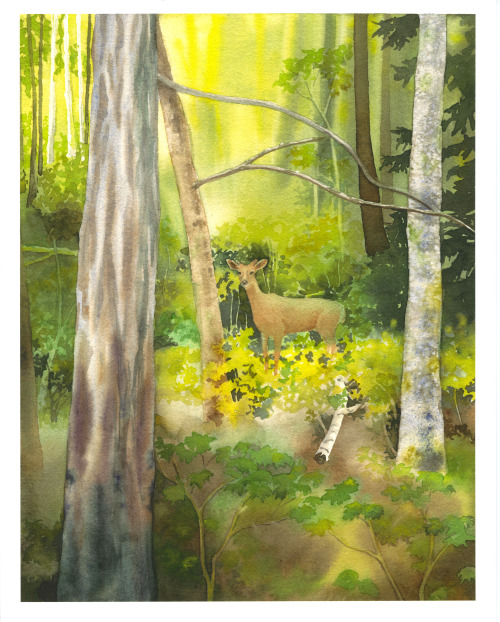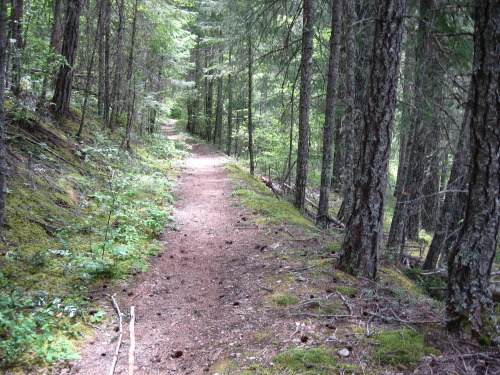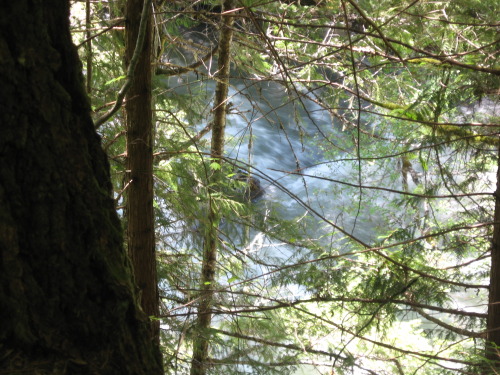Encounters: a Creative Residency at the North Cascades Institute

by Ilona Popper, North Cascades Institute Writer in Residence, Summer 2014
I was lucky enough to enjoy a brief writer-in-residency at the North Cascades Institute in May 2014. I gave two talks: one about wolves from the book I am writing and a joint talk on creativity with artist Molly Hashimoto. I attended Molly’s print-making class and heard her speak about the “surprises” of wildlife encounters that she captures in her prints and paintings. That sense of wonder was a large part of my time at the Institute.
I felt part of my role as writer-in-residence was to talk about writing—and writing about nature—with anyone who had an interest. I had some wonderful conversations at dinner with adult seminar students, graduate students, naturalists, and Institute staff. One man spoke passionately about how to get started on writing his memoirs. He felt he could never write well enough, even to begin. I was struck, as I often am, by how critical and severe people can be in judging their first efforts, dismissing their ideas before they are formed or condemning their craftsmanship in first drafts.
People often talk of the self-discipline of writers. It’s true that writers practice self-discipline, first in just getting the words down on paper regularly, but even more in learning to reread one’s work with open curiosity about where it might be going. Trashing your own ideas, your own writing, especially in an early draft, is easy. Sticking with revision until you’ve fully developed an idea—that takes discipline.
The bulk of my time at the Institute was filled with writing, hiking, discovering the local ecosystem and wildlife and learning about what North Cascades Institute does. I was impressed with the way that the food, the laundry, the classrooms — everything about the Institute’s campus — is part of a larger curriculum and ethic that supports the wide array of eco-educational programs at the Institute.
I’m a naturalist and I live in a rich and beautiful place, the Greater Yellowstone Ecosystem. Part of the value in being at North Cascades Institute was to see how the Northern Cascades ecosystem is so different from and yet linked with the wild lands in which I reside. I recently heard Christina Eisenberg speak of “The Predator Way” (the title of her book): the long corridor of the Rockies, inhabited by predator and prey mammals since the earliest eras. Wolves, cougar, lynx, wolverine and bear traveled the mountains as they dispersed, looking for new homes.
Predators are returning to the North Cascades and spreading throughout Washington state. I was thrilled to hear that wolves had been seen in one of the drainages not terribly far from the Institute campus. [See my my recent article, “Wolves in Washington: Lessons from Yellowstone,” Mt. Baker Experience, fall 2014.]
Animal Mind
In the Institute’s Wild Ginger Library, I picked up David Abram’s Becoming Animal. Abrams wrote about his being guided by a shaman to enter the mind and body of a raven he was watching. Throughout his book he’s emphasized lived, nonverbal, non-human-language-based communication and openness to the wild world.
I wonder a lot about the differing ways we humans are in relation to wildlife—and about the best ways to be in relation to wildlife. Wildlife watching, particularly, is a delicate art. It involves something akin to spying because the animal may not particularly want you to be there or to observe them. Often, animals fear humans. At the same time, wildlife watching is an essential form of schooling—you are studying something so huge and yet so fundamental to all life, our lives. You can feel overwhelmed and overjoyed.
I want to understand the animals I watch. However, there’s a balance between gawping, stepping too close, chasing an animal for a great camera shot, and respecting the animal’s personal space, looking for natural communications from the animal, and learning about the animal’s behavior, at least so we might know if we are disturbing it.
Do we humans become “rude” about animals partly to mask our insecurities, or our real animal instincts about danger? You can feel vulnerable in the woods, especially around large animals. We humans might handle that feeling by checking out, objectifying, or making snap judgments about the creatures, the situation. We can deny that the animals even notice us. Unable to read the body language—and hearing no language—we humans may assume the animals we see are sort of blank, wandering around like people on vacation. Or, we can make the opposite mistake and assume that we know exactly what they are thinking, wanting, or doing.
We wildlife watchers, usually well-fed and with some free time, may forget the pressures on wildlife. Many animals may simply be driven to get enough food for the day or find the right food for the season, or to play out other pressing needs, like avoiding getting killed by other animals, or mating, or delivering a baby. Sometimes, creatures may be resting, seriously resting to save and digest calories and repair tissue damage. I feel sure that at times, animals may be daydreaming, ruminating on more than cud. But, as with people, it’s almost impossible to know what’s really going on.
I try not to impose my interpretation about what any animal (or plant or rock) is doing. Yet, I have begun wondering if I also ignore communications that an animal might be sending me? Instead of acting as though they are all fascinating aliens, how can I act as though I am member of the animal world and live by the limitations and realities life imposes?
Encounter

One of my best experiences in my time at North Cascades Institute was during a hike on the East Bank trail in the North Cascades National Park. I went nearly three miles when I was stopped by a waterfall spring creek. I had already crossed several creeks but this one was just a little too intense for me. It was time for lunch anyway. I couldn’t have had a better setting: the sun moving in so many shadows and different colors of light in the trees and the creek.

I had two unusual encounters with deer on this walk. The first followed my lovely lunch on the trail. Here’s my journal, from field notes:
May 20, 2014
…The trail I’m traveling (is bordered by) a steep, tangled ravine on the left and …a high wooded hill on the right. I come around a corner and find one large doe standing in the middle of the trail. She’s looking at me with some alarm. After a second or two of our staring at each other, she runs up the hill and freezes. Now, I see that several deer are also peering at me through some foliage. Very slowly I step a little to the left and see that there is a small female yearling and two other does. They remain frozen. Then the lead doe rejoins her group.
I inch further left to a small earth promontory, a little pull-out off the trail. It’s perched above the ravine. As I step aside I say in a very calm voice, “Do what you need to do.” (I mean, “Go past me if you need to,” but I form the words in order to focus my own intentions.)
I get very still and I avert my eyes. Almost immediately, the doe closest to me, I’ll call it the second doe, takes a step, waits and then walks briskly by me. As she gets closest to me on the trail, I feel how large and near she is. I think, “Do what you need to do, but please don’t hurt me!” Have I placed myself in more danger than I realized? The lead or first doe follows that second one, but when she gets nearest to me, she angles up the hill away from me and then climbs down to the trail.
Now the youngest, a small yearling, stops and watches me. The last doe behind her peers at me too. I remain still, eyes averted, and repeat, “Do what you need to do.” The yearling steps, stops, starts a little, walks, stops, and then trots past me. She sticks to the trail which brings her close.
Finally, the last and most skittish doe stands for a while. She’s one of the largest of the group. I want to look in her face, but make myself keep my eyes averted. As she hesitates, I feel, rather than see, the yearling returning behind me, very close. Is she sniffing me? I can’t look because I know they will scatter if I turn my head.
At first, I believe the yearling is actually curious about me or even trying to communicate something to me. Suddenly, it seems the yearling is made bold for another reason. Out of the corner of my eye, I see that she focuses her gaze on the nervous doe, as if to say, “Are you coming? We can’t leave you behind,” or possibly, “See, it’s safe to risk it.” But, I really don’t know why the little deer came back. I don’t know if this doe was her mother.
I look into the eyes of that last doe—I’m between her and the others—and I think again, “Do what you need to do.” She runs up the hill around me and down to the others. I am flooded with happiness that none of them bolted and that they seem to be traveling the route they’d chosen.
I step on the trail and look back at them. The deer have already covered some ground. The three in the lead are all trotting, ears back. But that last, large doe, stands studying me. Her expression has some vigilance in it, but, it seems to me, also a smidgen of curiosity. She’s watches me for some time, and I turn away first.
Ilona Popper is a poet and naturalist who lives near Yellowstone National Park and writes about wildlife. She’s working on a book about observing, living among and the science about wild wolves. Her blog is ilonapopper.wordpress.com. Top artwork by Molly Hashimoto.
North Cascades Institute believe that creativity and the arts improve education and we invite working artists, writers and naturalists from a broad spectrum disciplines to apply for our Creative Residency program at the North Cascades Environmental Learning Center. The goal of the Learning Center’s Creative Residency program is to bring creative people working in a wide variety of genres — poets, naturalists, painters, essayist, dancers, novelists, photographers, sculptors, teachers, printmakers, memoirists, researchers and others using the creative process to explore and interpret the natural world — to the Environmental Learning Center to pursue their art and demonstrate the many forms that creativity takes. Learn more at www.ncascades.org/creative-residencies.


Thank you for the article in the fall issue of Mt. Baker Experience. It hopefully will help defuse things a little over here in the Methow. -EB,Mazama
Beautiful piece of writing Ilona. Loved it! Joanna
Ilona, you wrote beautifully about the encounter with the deer on the East Bank Trail and I wish sincerely that I could have been with you, but perhaps they would have fled had there been 2 of us!